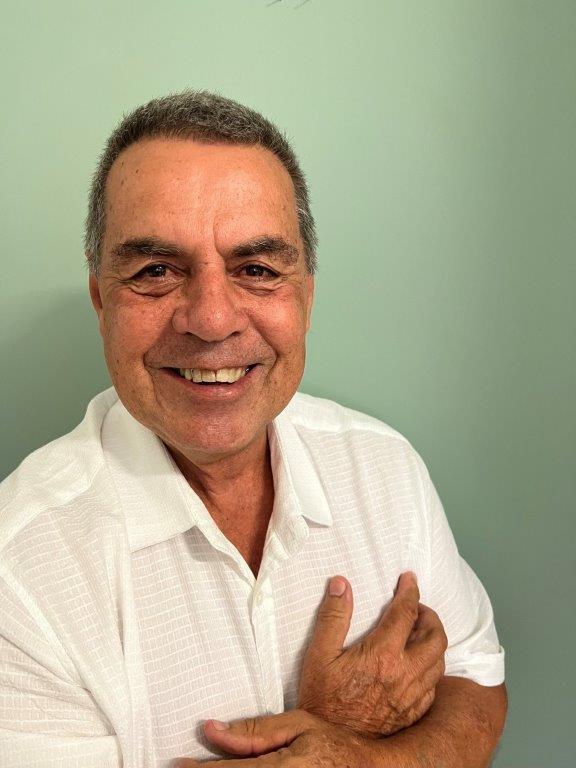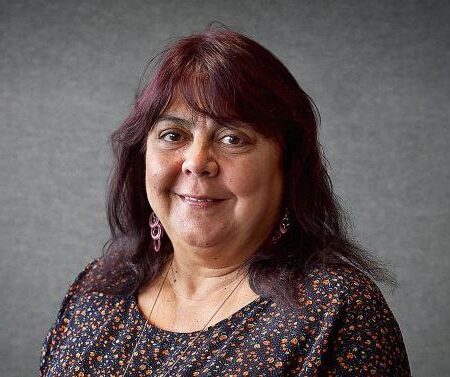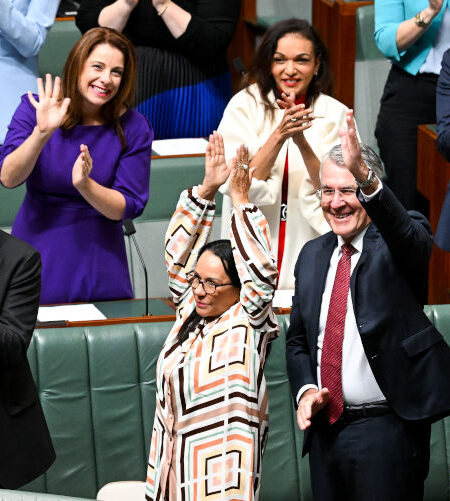The onset of the COVID pandemic last year was difficult for people everywhere, with border and school closures, the isolation of working from home, movement restrictions, and face mask wearing, to name a few. For First Nations Peoples across Australia, the past 12 months have been especially hard.
The Black Lives Matter movement was initiated in the US in 2013 after the acquittal of George Zimmermann for the shooting death of a 17-year-old unarmed African American teenager. In May 2020, Black Lives Matter roared back into prominence when African American man George Floyd died after a police officer kneeled on his neck for almost nine minutes. An estimated 15 million people took to the streets to protest across the US and prompted nation-wide rallies here in Australia, drawing attention to racism, police brutality and the deaths in custody of First Nations Peoples.
Dunghutti man David Dungay Jr died in a Sydney prison cell in 2015 after officers restrained him to stop him eating biscuits. During the struggle, he was pinned face-down by guards and jabbed with a sedative. Video later shown at his inquest captured his final moments: his laboured breathing and muffled screams under the pack of guards. “I can’t breathe” he gasped repeatedly. Dungay’s case has close parallels to that of George Floyd’s, with the Black Lives Matter movement throwing a spotlight on Australia’s own shameful record of incarceration and deaths in custody of our First Nations Peoples.
The system is continuing to kill us and no one’s doing anything about it.
Paul Silva, the nephew of David Dungay Jr.
April this year marked 30 years since the Royal Commission into Aboriginal Deaths in Custody (RCIADIC), a landmark inquiry at the time. RCIADIC made hundreds of recommendations to address the crisis. But three decades on, the situation has worsened with overrepresentation central to the problem. Aboriginal and Torres Strait Islander peoples are about 12 times more likely to be in custody than non-Indigenous Australians. That reality, a product of systemic problems and disadvantages faced by First Nations Peoples in Australia, has prompted fresh anger over the lack of action.
How many Aboriginal and Torres Strait Islander peoples have died in custody?
Since 1991, at least 474 First Nations Peoples have died in custody, with another nine since March alone. While First Nations Peoples don’t necessarily die at a greater rate than non-Indigenous people in the justice system, they are much more likely to be in prison or police lock-up to begin with. That was the finding of the 1991 RCIADIC inquiry and has continued to this day. Aboriginal and Torres Strait Islander peoples have the highest rate of incarceration of any group in the world. Roughly half of all juvenile prisoners are First Nations children, many of whom are in custody without having been sentenced – they may have been taken to a police holding cell or ‘safe house’ for the night, or may not have money to post bail.
Are police held accountable for deaths in custody?
Currently, there are three ongoing criminal trials of police officers in separate cases who are alleged to have killed a First Nations person in custody. But these are rare prosecutions, the first since the 1980s. Deliberate violence, brutality or misconduct by police and prison officers is not the main reason attributed to so many Aboriginal and Torres Strait Islander peoples dying in custody. This is illustrated in a Guardian Australia database tracking all deaths since 1991. RCIADIC also found no evidence of police foul play in the 99 cases it examined, but also didn’t excuse officers of culpability. It found that authorities had ‘less dedication to the duty of care owed to persons in custody’ when they were a First Nations person.
So, what else is to blame?
In many cases, First Nations deaths in police custody are due to systemic neglect. Many of these deaths are due to inadequate medical care, neglect and lack of attention, and to self-harm. The Guardian database shows First Nations Peoples are three times less likely to receive medical care than others. Both the commissioners 30 years ago, and advocates today, say that racist attitudes and assumptions drive this neglect and inaction. They argue racism leads to police officers ignoring cries for help from Aboriginal and Torres Strait Islanders in custody, or taking too long to attend to their medical needs.
Take the case of Nathan Reynolds, who died in 2017 from an asthma attack after prison guards took too long to respond to his emergency call. A coroner ruled his death was preventable and the “unreasonable delay” deprived him of some chance of survival. His family say officers:
stereotyped him as a drug user because he was black and in jail.
The officers didn’t care, they say:
Corrective officers walked to Nathan, they did not run. They took 11 minutes to arrive while our brother’s life hung in the balance.
The family of Tanya Day also say racist attitudes led to her death. She died from head injuries in a police cell in 2017 just hours after being arrested on a train for public drunkenness. A coroner found her cries for help were ignored by police at the station. She should not have been arrested in the first place, the coroner said, noting that “unconscious bias” led to her being taken into custody.“Knowing that our mum died in police custody because she was an Aboriginal woman is extremely hard” her daughter, Apryl Day, said in a statement.
She went on to say, after her mother was taken in, the same officers later that day attended a call-out for a heavily drunk white woman: “But instead of arresting her and fining her like they did my mum, they drove that woman home. They didn’t even fine her, that woman is alive and well today and our mum is not.”
What action is being taken?
The government says most of the 339 recommendations made by RCIADIC have been fully enacted, but this is strongly rebuffed by its political opposition, social welfare workers, and activists.The inquiry recommended incarceration only be used as a last resort. Mandatory detention for minor offences should be abolished, along with raising the minimum age of criminal responsibility. It said States should set up sobering-up shelters to bring people to instead of prison cells. But the inquiry also outlined how historical dispossession of First Nations Peoples has led to generational disadvantages in health, schooling and employment. These gaps create situations where First Nations Peoples face the police, courts and prison system.Three decades on, little progress has been made.
Aboriginal and Torres Strait Islander peoples now make up around 30 percent of the prison population. First Nations lawmakers have called for leadership, including crisis talks between Federal and State governments. They also want a formal reporting system on Aboriginal and Torres Strait Islander deaths in custody. The Federal Government has scarcely commented on the anniversary of the RCIADIC inquiry.
The Federal Government has a target to reduce the rate of Indigenous incarceration by 15 per cent by 2031. But its own data shows they’re not on track to meet this goal unless drastic action is taken.
The opposition Labor party has pledged $90 million to reduce Aboriginal and Torres Strait Islander incarceration. Still, many are unconvinced that the political will exists to fix the problem.
Here we are today, still losing our loved ones in the same manner, suffering the same trauma that prompted the royal commission,
said Apryl Day. She and other bereaved families have been campaigning for months to meet Prime Minister Scott Morrison on the crisis, with no luck:
Our lives are ignored in this country. It’s just a constant cycle of violence being perpetrated.
I could go on, get angry, yell, jump up and down, but who is listening besides our mob. Maybe the way to talk about reconciliation in Australia is the Aboriginal way, by listening to our Music, our Songs and Stories.
For me this clearly demonstrates First Nations Peoples’ Perseverance, Resilience, Patience & Love.
These are some of the stories, when alone, I reflect on, cry and gain strength from to continue being a strong voice and a quiet activist for Reconciliation.
Vincent Lingiari AM and the Wave Hill walk-off
Vincent Lingiari, AM (13 June 1908–21 January 1988) was a First Nations’ rights activist and member of the Gurindji people. In his early life he started as a stockman at Wave Hill Station, where the Aboriginal workers in the employ of station owners Vestey Brothers were given no more than rations, tobacco and clothing as their payment. After Vestey refused to improve pay and working conditions at the cattle station and hand back some of Gurindji land, Lingiari was elected and became the leader of the workers in August 1966. He led his people in the Wave Hill walk off, also known as the Gurindji strike.
While there had been complaints from Aboriginal employees about conditions on Wave Hill over many years, including an inquiry during the 1930s that was critical of Vestey’s employment practices, the walk-off had a focus that was aimed at a wider target than Vestey’s. Before 1968 it was illegal to pay an Aboriginal worker more than a specified amount in goods and money. In many cases, the government benefits for which Aboriginal employees were eligible were paid into pastoral companies’ accounts, rather than to the individuals.
The protesters in the walk-off established the Wattie Creek (Daguragu) camp and demanded the return of some of their traditional lands. Speaking on this Lingiari said, “We want to live on our land, our way”. So began the eight-year fight by the Gurindji people to obtain title to their land.
The Wave Hill strike would eventually reshape the agenda of relationships between First Nations Peoples and the wider community. Although initially an employee-rights action, it soon became a major federal issue when the Gurindji people demanded the return of their traditional lands.
Over the eight year strike, support for Aboriginal land rights grew as the struggle intensified. The protest eventually led to the Aboriginal Land Rights (Northern Territory) Act 1976. This act was the basis by which Aboriginal Australian and Torres Strait Islander people could apply for freehold title to traditional lands (known as Native title in Australia) in the Northern Territory and, significantly, the power to negotiate over mining and development on those lands, including what type of compensation they would like.
An important and symbolic event in Australian history occurred when, during an emotional ceremony in 1975, Prime Minister Gough Whitlam poured the local sand into Lingiari’s hands, symbolically handing a small part of land belonging to the Wave Hill station back to the Gurindji people, on a 30-year pastoral lease. A photograph of the moment captured by Mervyn Bishop was purchased by the National Portrait Gallery and is displayed in Old Parliament House.
Lingiari was a leader and holder of the cultural authority of the Gurindji people. His fight for his people’s rights made him a national figure. He won a victory that is one of the most outstanding achievements in the history of the struggle for the recognition of First Nations Peoples, and initiated awareness to non-Indigenous people of the intense connections between Indigenous peoples and their land.
Lingiari and the Wake Hill walk off inspired the song From Little Things Big Things Grow by Paul Kelly and Kev Carmody, a song that when I’m alone I sing out loud – it’s an anthem of inspiration.
Archie Roach and the Stolen Generations
For decades, the Australian Government implemented a genocidal policy of ripping First Nations children away from their families. This resulted in the ‘Stolen Generations’. Archie Roach’s song, ‘Took the Children Away’ (1988) tells this story and his own history. It’s a song that also resonates strongly now with the forced separation of asylum-seeking families. The song finishes with the return of the children – Archie included – offering us hope for the long run.
Australian musician Paul Kelly invited Archie to open his concert with the song early in 1989, where his performance was met with stunned silence, followed by shattering applause. The song became significant as it was released at a time when there was increasing public focus on the Stolen Generations.
Archie’s autobiography, Tell Me Why (2019) states:
For the past ten years a team of geologists, archaeologists and paleontologists have found evidence, although inconclusive, of a ‘place of fire’ at a location called Moyjil by the Gunditjmarra and Point Ritchie by European settlers. There, small black stones and scattered shell middens were collected around steep cliffs, ‘heated in a situation reminiscent of a heath’.
For so long we have been divided by ‘isms’ – racism, sexism, fundamentalism, individualism – but when we come back to the place of fire, I believe we will discover there’s far more that connects us than separates us. I believe there will be one humanity again, that we will find release, healing and true freedom.
The ‘place of fire’ is a place of love and connection. We’ll all be there – I’ll be there-to welcome you back, wrap my arms around you and say, ‘I’ve missed you. Welcome home’.
An extraordinary First Nations man who has lived a life like no other. Stolen child, tragic, heartbreaking, musical and lyrical genius and leader.
Back to the question, is Reconciliation dead in Australia?
Well, one answer would be a resounding ‘yes’ from the racists and fence sitters – at least from many First Nations’ and multicultural Australians’ point of view. A bold and brave statement maybe, but as a First Australian about to reach the age of 70, this is my lived life experience – we live in an undeniably racist country. The pub talk, chats around the BBQ, attitudes on public transport, on holidays – the racism and negativity is real and appalling.
So, what can we do about racism as First Nations Peoples in Australia?
March, protest, wave our flag, and speak strong! Some of us do just that and are joined and supported by many non-Indigenous allies. Remember the estimated 250,000 people from all backgrounds who marched across the Sydney Harbour Bridge for Reconciliation 21 Years ago? 21 years ago! And yet Aboriginal and Torres Strait Islander peoples are still today often vilified, ignored, dis-respected and treated with contempt.
However, we persist with dignity and empathy. From our perspective as First Nations Peoples, reconciliation is not dead. Our hand is always extended, we’re ready to embrace genuine reconciliation efforts from non-Indigenous Australians where and when they come. We will continue in our own individual ways to articulate reconciliation, which is making a difference. We will persevere from all our places – high academic, political, at a grassroots level, and I’ll keep supporting all of those who are working for unity in my quiet activist way.
Aboriginal and Torres Strait Islander peoples make up only three percent of the population, so any vote for advancing our causes such as a Voice to Parliament requires a YES from a great number of non-Indigenous Australians. More than ever we need our friends to take our outstretched hands for Reconciliation.
The stories, songs and music here are about reconciliation and love for each other as Australians – ‘With a Little Help From My Friends’ by Dan Sultan and Ella Hooper is a good one to finish on.




